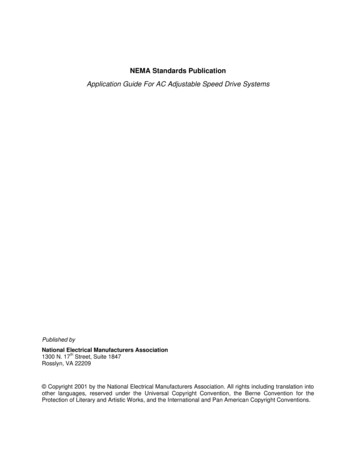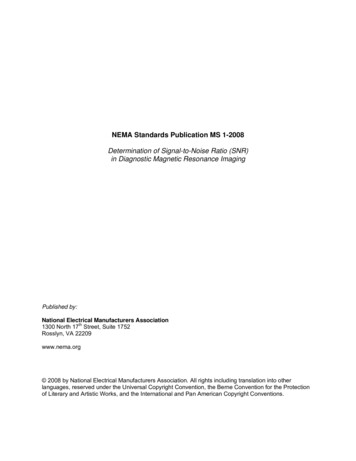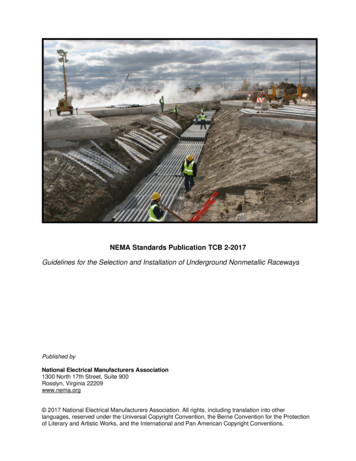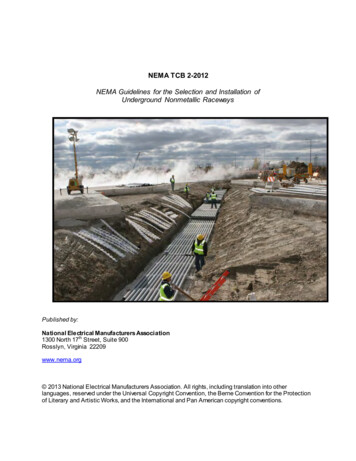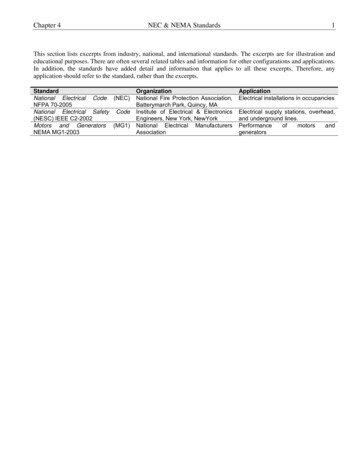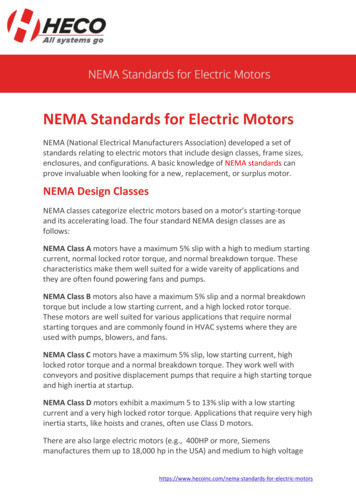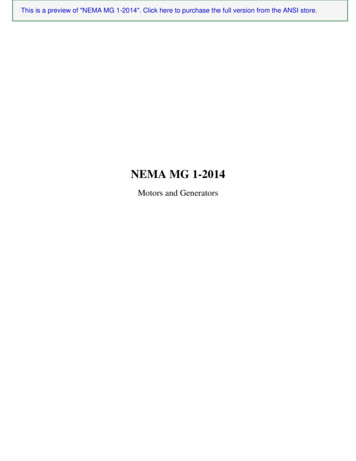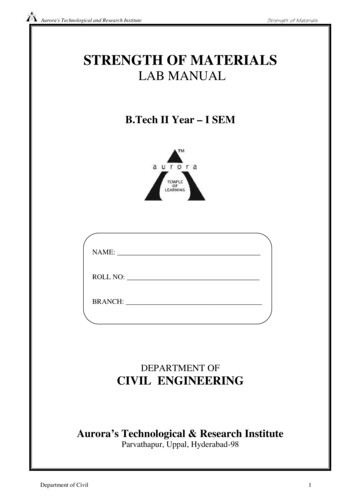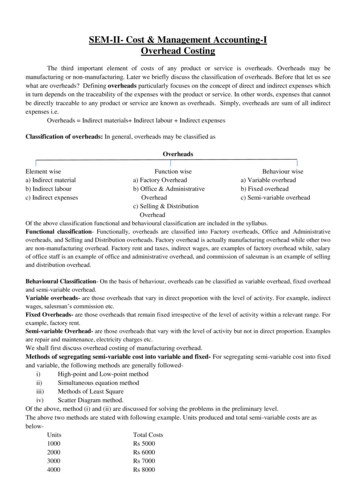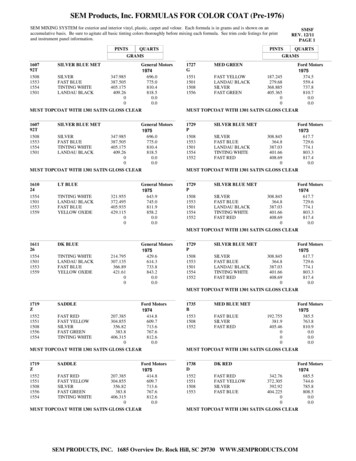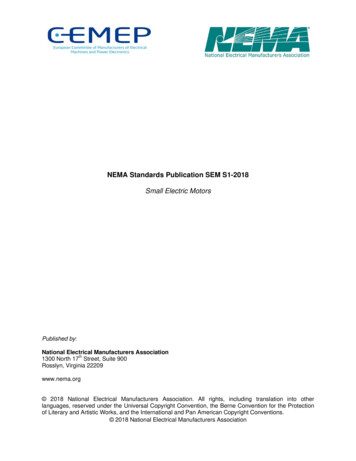
Transcription
NEMA Standards Publication SEM S1-2018Small Electric MotorsPublished by:National Electrical Manufacturers Association1300 North 17th Street, Suite 900Rosslyn, Virginia 22209www.nema.org 2018 National Electrical Manufacturers Association. All rights, including translation into otherlanguages, reserved under the Universal Copyright Convention, the Berne Convention for the Protectionof Literary and Artistic Works, and the International and Pan American Copyright Conventions. 2018 National Electrical Manufacturers Association
NOTICE AND DISCLAIMERThe information in this publication was considered technically sound by the consensus of personsengaged in the development and approval of the document at the time it was developed. Consensusdoes not necessarily mean that there is unanimous agreement among every person participating in thedevelopment of this document.NEMA standards and guideline publications, of which the document contained herein is one, aredeveloped through a voluntary consensus standards development process. This process brings togethervolunteers and/or seeks out the views of persons who have an interest in the topic covered by thispublication. While NEMA administers the process and establishes rules to promote fairness in thedevelopment of consensus, it does not write the document and it does not independently test, evaluate,or verify the accuracy or completeness of any information or the soundness of any judgments containedin its standards and guideline publications.NEMA disclaims liability for any personal injury, property, or other damages of any nature whatsoever,whether special, indirect, consequential, or compensatory, directly or indirectly resulting from thepublication, use of, application, or reliance on this document. NEMA disclaims and makes no guaranty orwarranty, express or implied, as to the accuracy or completeness of any information published herein,and disclaims and makes no warranty that the information in this document will fulfill any of your particularpurposes or needs. NEMA does not undertake to guarantee the performance of any individualmanufacturer or seller’s products or services by virtue of this standard or guide.In publishing and making this document available, NEMA is not undertaking to render professional orother services for or on behalf of any person or entity, nor is NEMA undertaking to perform any duty owedby any person or entity to someone else. Anyone using this document should rely on his or her ownindependent judgment or, as appropriate, seek the advice of a competent professional in determining theexercise of reasonable care in any given circumstances. Information and other standards on the topiccovered by this publication may be available from other sources, which the user may wish to consult foradditional views or information not covered by this publication.NEMA has no power, nor does it undertake to police or enforce compliance with the contents of thisdocument. NEMA does not certify, test, or inspect products, designs, or installations for safety or healthpurposes. Any certification or other statement of compliance with any health or safety-related informationin this document shall not be attributable to NEMA and is solely the responsibility of the certifier or makerof the statement. 2018 National Electrical Manufacturers Association
Energy Conservation Standards for Special- and Definite-Purpose Small Electric Motors willcomplicate the design and manufacturer of motor driven systems for motor manufacturers,Original Equipment Manufacturers (OEM) and consumers while saving little if any, energy duringthe system’s operating life. Improvement in energy savings should come from reducing theenergy use of motor driven systems, not motor component regulation.The purpose of this document is to describe current concerns about possible future pathways that smallelectric motor [1/4 up to 3 HP or 120 W up to 2.2 kW] regulation in Europe and the United States maytake and review options. It is the position of NEMA and CEMEP that great care must be taken whendeveloping motor market regulations to avoid adverse effects (e.g., rebound effects that offset potentialincremental motor efficiency improvement), on the end-users and the suppliers of electric motors, on theeconomy and natural resources.Recommendations from CEMEP and NEMA:1. Motor driven systems (i.e., appliances/devices) should be the focal point at which energysavings are measured and potentially regulated by the U.S. DOE or EuropeanCommission.2. Motor driven system energy savings based on power losses (kW) at the appliance/devicelevel is a more meaningful metric to measure energy savings benefits and should be usedin place of a single point motor efficiency metric determined under controlled laboratoryconditions.3. Future regulations need to address the way products reach the market acknowledging thatmotors are embedded components used in concert with many other components of thesystem to achieve desired effectiveness and optimum energy savings.4. Utilize IEC standards [61800-9-1, 2] 1 that will provide regulators and system suppliers ameans to measure and predict energy savings.5. Provide greater incentives and recognition of suppliers to expand applications of powerdrive systems that manage speed and load to reduce overall power consumption in motordriven systems.In the case of small motors, regulation of these products presents unique concerns that are muchdifferent than medium power motors [1 up to 500 HP or 0.75 kW up to 375 kW] that are currentlyregulated with a much broader scope.In the United States, the current small electric motor minimum energy efficiency regulation applies togeneral purpose alternating current induction motors. These are open motors ranging from 1/4 up to 3horsepower, also known as 2-digit frame size types. Excluded from the scope of this regulation are“special-purpose” motors with special construction or operating characteristics designed for a particularapplication, and “definite-purpose” motors for use in unusual service conditions or on a particular type ofapplication and that cannot be used in most general purpose applications. Special- and definite-purposemotors are frequently used in other regulated devices and appliances. Current legislation prohibited the1The NEMA Motor and Generator Section is working to add this standard to NEMA Standards MG-1 inthe next update 2018 National Electrical Manufacturers Association
Department of Energy from applying its initial general purpose small motor regulation to other regulatedappliances, but that legislative restriction may not apply to future regulation.Europe does not currently regulate the efficiency of small electric motors (motors with a power range lessthan 0.75 kW or roughly 1 horsepower), 2 nor does the European Union treat small electric motorsseparate from higher horsepower motors with larger frame sizes as the United States legislation does.Unlike the United States, the European Union does not recognize differences between general purposesmall motors and special- and definite-purpose motors. Pending regulatory proposals in the EuropeanUnion would ignore the significant differences and applications between small motors and larger ormedium motors from 1-500 horsepower and general purpose and special- and definite-purpose smallmotors.In this paper, we identify two potential regulatory pathways that future small motor efficiency regulationmight take: (1) regulate additional types of small motors than those currently regulated; 3 (2) imposehigher efficiency standards on small motors that are currently regulated. For the reasons explainedherein, neither is desirable, and we propose an alternate scheme to achieve energy savings by regulatingmotor driven systems.It is the position of NEMA and CEMEP that new or amended energy efficiency regulations for smallelectric motors do not make sense in the scheme of energy conservation standards as a whole in Europeand the United States. There is a better way of securing energy savings from motor driven systems inwhich a small electric motor is a component. Expanding the scope of the small electric motor energyconservation standards could lead to significant impacts on the cost of consumer and commercialappliances and devices which use small electric motors. Furthermore, since many of these consumer andcommercial appliances and devices are also subject to their minimum energy performance standards achange in a component (motor) does not guarantee a change in final system performance.To advance energy savings in this area, NEMA and CEMEP propose a different, more sensible andeffective approach that would no longer focus on regulation of the efficiency of the motor component, butlook at reducing overall losses of an appliance and improving energy savings of motor driven systems. 42Current EU Minimum Energy Performance Standard for electric motors covers 2, 4, and 6 pole singlespeed, three-phase induction motors in a power range of 0.75–375 kW rated up to 1000V. These includeall duty types capable of continuous operation. These are “medium” motors. EC 640/2009 as amendedby EU 4/2014.3This was the approach taken by the U.S. Department of Energy in amending energy conservationstandards for “electric motors” (generally medium motors 1-500 horsepower). NEMA petitioned andsupported the U.S. DOE to take this approach for electric motors. See 79 Federal Register 30934 (May29, 2014). This approach is not appropriate for small electric motors, as we explain herein.4See e.g., J.Ritchie, Energy efficiency of electric motors: status, prospects and challenges at slide 14(September 6, 2017, Presentation to EEMODS conference) (Mr. Ritchie an energy policy analyst at theInternational Energy Agency (IEA) calculates that energy savings from “more efficient end use devices[using motors] and “other system wide measures” significantly exceeds energy savings from makingmotor components more efficient). 2018 National Electrical Manufacturers Association
We refer to this approach, sometimes, as “extended product regulation” because it looks at regulation ofthe “extended product” or “system” of which the small electric motor is just one energy-using component.The U.S. Department of Energy recognizes the sense in addressing energy consumption of a system inuse, rather than assuming component regulations guarantee energy savings. In recent years, DOE hasbegun using an approach which examines the “Extended Product Regulation.” 5 This approach moreaccurately addresses energy consumption performance in terms of the final commercial application andavoids rebound effects instead of continuing regulation of the motor component. Minimum energyperformance standards which assess and address the equipment or appliance as a whole (i.e., other thanjust the motor) are more likely to reflect true energy savings and more accurately examine downstreamimpacts of regulation on component suppliers, OEMs, and consumers. As such, NEMA and CEMEP donot support additional investment in energy efficiency regulations for electric motors or small electricmotors using the component approach.The 2010 DOE regulation for general purpose small electric motors 6 required 50% of motor designs tochange in physical dimension by one inch, in diameter or length, as a result of adding active material toincrease electrical efficiency. Additionally, approximately 60% of these new designs required the additionof an external capacitor to increase efficiency. Both of these physical changes could significantly alter thefit of a special- or definite-purpose application in which the device is built around the motor or vice-versa.Also not fully understood or investigated yet is whether the increased speed of rotation results inadditional energy usage, depending on the type of load present. This is because even at a greaternominal efficiency the actual power used increases with the higher speed unless the user modifies hisapplication to return the system to the original design speed. In the United States, small motors arepresent in almost 50% of other regulated product classes: 28 of 60 covered products DOE regulates maycontain a small electric motor. Expanding this to product types within each class could see hundreds orthousands of products impacted by motor alterations due to a change in energy efficiency regulation ofsmall motors.If a regulator decides to investigate potentially expanded coverage of small electric motor standards, itfollows that the downstream impact to each regulated appliance by class and type must also be analyzedwith respect to redesign burdens and cost burdens. This is not only for small motor manufacturers butalso for OEMs and the consumers of the OEMs appliances and devices. This appliance analysis mustalso quantify the likelihood of little or no overall appliance efficiency changes, given that other internaldesign considerations for device or appliance manufacturers may be made to limit cost or size growth.Such a trade-off would mean that while the cost of the appliance increased due to changes incomponents, there would be no increased energy savings in appliance performance to offset the addedcosts.If small electric motor regulations are expanded to include special- and definite-purpose motors, it followsthat all downstream devices, appliances, and equipment which use those small motors must also be5See the DOE Commercial and Industrial Pumps rulemaking and C&I Compressors andards-and-test-procedures675 Federal Register 10874 (March 9, 2010). 2018 National Electrical Manufacturers Association
reevaluated and in many cases redesigned. Improving motor efficiency often requires a motormanufacturer to redesign its motor, and this can affect the physical dimensions of the motor making itlarger. A larger motor can require a system integrator to redesign its appliance to accommodate the larg
NEMA standards and guideline publications, of which the document contained herein is one, are developed through a voluntary consensus standards development process. This process brings together volunteers and/or seeks out the views of persons who have an interest in the topic covered by this publication. While NEMA administers the process and establishes rules to promote fairness in the .
